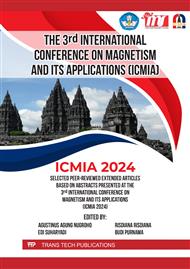[1]
T. Dietl, H. Ohno, F. Matsukura, J. Cibert, and D. Ferrand, Science 287, 1019 (2000).
Google Scholar
[2]
H. Ohno, J. Appl. Phys. 113, 136509 (2013).
Google Scholar
[3]
Y. Ogawa, H. Akinaga, F. Takano, T. Arima, and Y. Tokura, J. Phys. Soc. Jpn. 73, 2389 (2004).
Google Scholar
[4]
J. M. D. Coey, Solid State Mater. Sci. 10, 83 (2006).
Google Scholar
[5]
K. P. McKenna and D. M. Ramo, Phys. Rev. B 92, 205124 (2015).
Google Scholar
[6]
N. H. Hong, J. Sakai, N. Poirot, and V. Brizé, Phys. Rev. B 73, 132404 (2006).
Google Scholar
[7]
N. H. Hong, N. Poirot, and J. Sakai, Phys. Rev. B 77, 033205 (2008).
Google Scholar
[8]
K. Potzger, S. Zhou, J. Grenzer, M. Helm, and J. Fassbender, Appl. Phys. Lett. 92, 182504 (2008).
DOI: 10.1063/1.2938419
Google Scholar
[9]
S. M. Evans, N. C. Giles, L. E. Halliburton, and L. A. Kappers, J. Appl. Phys. 103, 043710 (2008).
Google Scholar
[10]
Y. Liu, L. Jiang, G. Wang, S. Zuo, W. Wang, and X. Chen, Appl. Phys. Lett. 100, 122401 (2012).
Google Scholar
[11]
P. Dev, Y. Xue, and P. Zhang, Phys. Rev. Lett. 100, 117204 (2008).
Google Scholar
[12]
C. Madhu, A. Sundaresan, and C. N. R. Rao, Phys. Rev. B 77, 201306(R) (2008).
Google Scholar
[13]
M. Y. H. Widianto, H. P. Kadarisman, A. M. Yatmeidhy, and M. Saito, Japanese Journal of Applied Physics 59, 071001 (2020).
Google Scholar
[14]
O. Volnianska and P. Boguslawski, Phys. Rev. B 83, 205205 (2011).
Google Scholar
[15]
O. Volnianska and P. Boguslawski, J. Phys.: Condens. Matter 22, 073202 (2010).
Google Scholar
[16]
P. Dev and P. Zhang, Phys. Rev. B 81, 085207 (2010).
Google Scholar
[17]
F. Máca, J. Kudrnovský, V. Drchal, and G. Bouzerar, Applied Physics Letters 92, 212503 (2008).
DOI: 10.1063/1.2936858
Google Scholar
[18]
M. Boujnah, H. Labrim, K. Allam, et al., J. Supercond. Nov. Magn. 26, 2429–2434 (2013).
Google Scholar
[19]
T. Archer, C. D. Pemmaraju, and S. Sanvito, J. Magn. Magn. Mater. 316, e188 (2007).
Google Scholar
[20]
T. Yamasaki, A. Kuroda, T. Kato, J. Nara, J. Koga, T. Uda, K. Minami, and T. Ohno, Computer Physics Communications 244, 264 (2019).
DOI: 10.1016/j.cpc.2019.04.008
Google Scholar
[21]
J. P. Perdew, K. Burke, and M. Ernzerhof, Phys. Rev. Lett. 77, 3865 (1996).
Google Scholar
[22]
Musyarofah, N. D. Lestari, R. Nurlaila, N. F. Muwwaqor, Triwikantoro, and S. Pratapa, Ceramics International 45, 6639 (2019).
DOI: 10.1016/j.ceramint.2018.12.152
Google Scholar
[23]
M. Y. H. Widianto and M. Saito, Japanese Journal of Applied Physics 61, 035503 (2022).
Google Scholar
[24]
X. Lu, K. Liang, S. Gu, Y. Zheng, and H. Fang, Journal of Materials Science 32, 6653–6656 (1997).
Google Scholar
[25]
H. Kwak and S. Chaudhuri, Surface Science 604, 2116 (2010).
Google Scholar
[26]
S. Fabris, A. T. Paxton, and M. W. Finnis, Acta Materialia 50, 5171 (2002).
Google Scholar
[27]
Q. Wang, Q. Sun, G. Chen, Y. Kawazoe, and P. Jena, Phys. Rev. B 77, 205411 (2008).
Google Scholar
[28]
D. Y. Pratama, B. Hariyanto, S. Y. Purwaningsih, A. M. Hatta, and S. Pratapa, Physica Scripta 99, 085971 (2024).
DOI: 10.1088/1402-4896/ad6246
Google Scholar
[29]
C. C.W. K.-Gamage and F. Ramezanipour, J. Phys. Chem. Sol. 171, 111013 (2022).
Google Scholar
[30]
K. Kliemt, J.D. Reusch, M. Bolte, and C. Krellner, J. Mag. Mag. Mat. 552, 169199 (2022).
Google Scholar
[31]
S. Pattanaik, D. K. Mishra, M. K. Sharma and R. Chatterjee, Inor. Chem. Commun. 118, 1080 (2020).
Google Scholar



